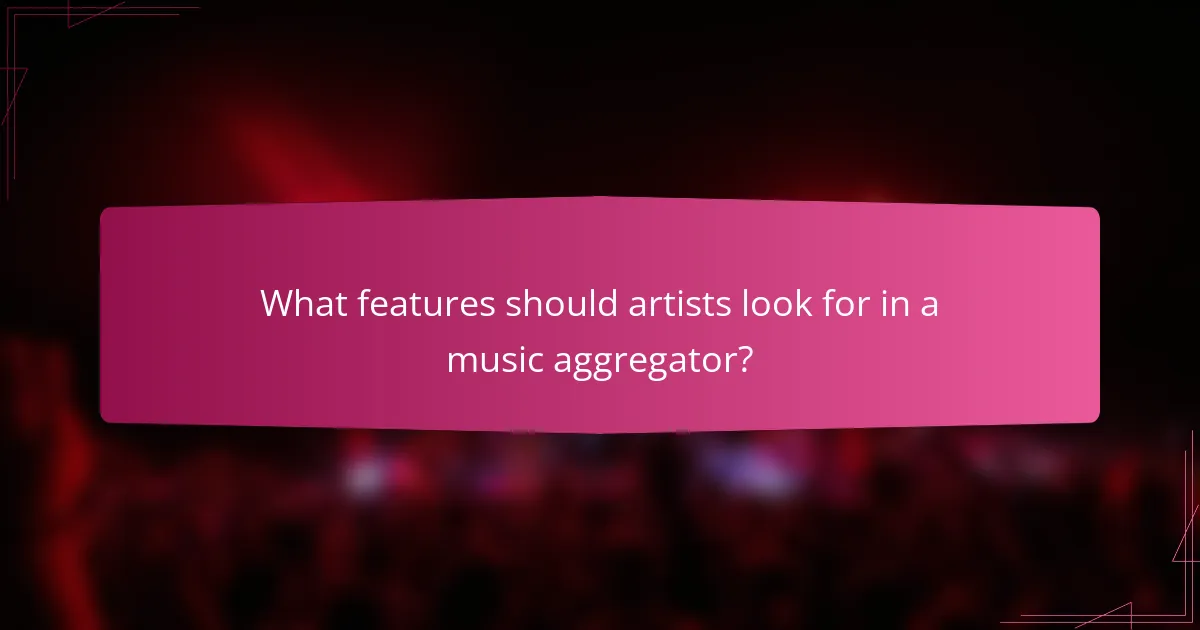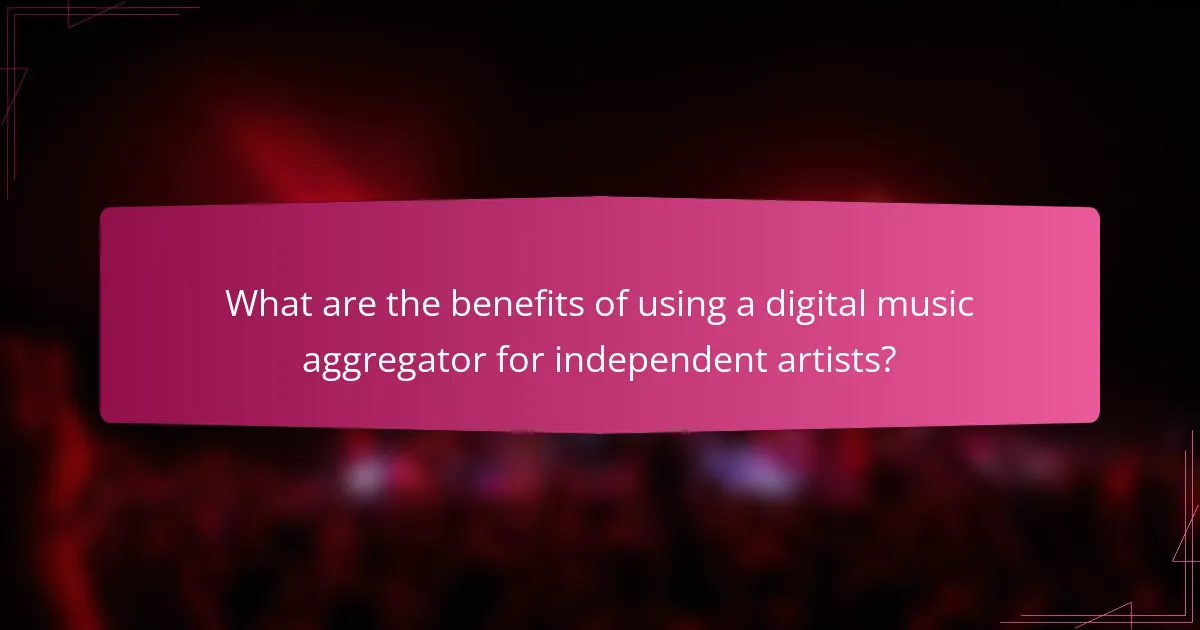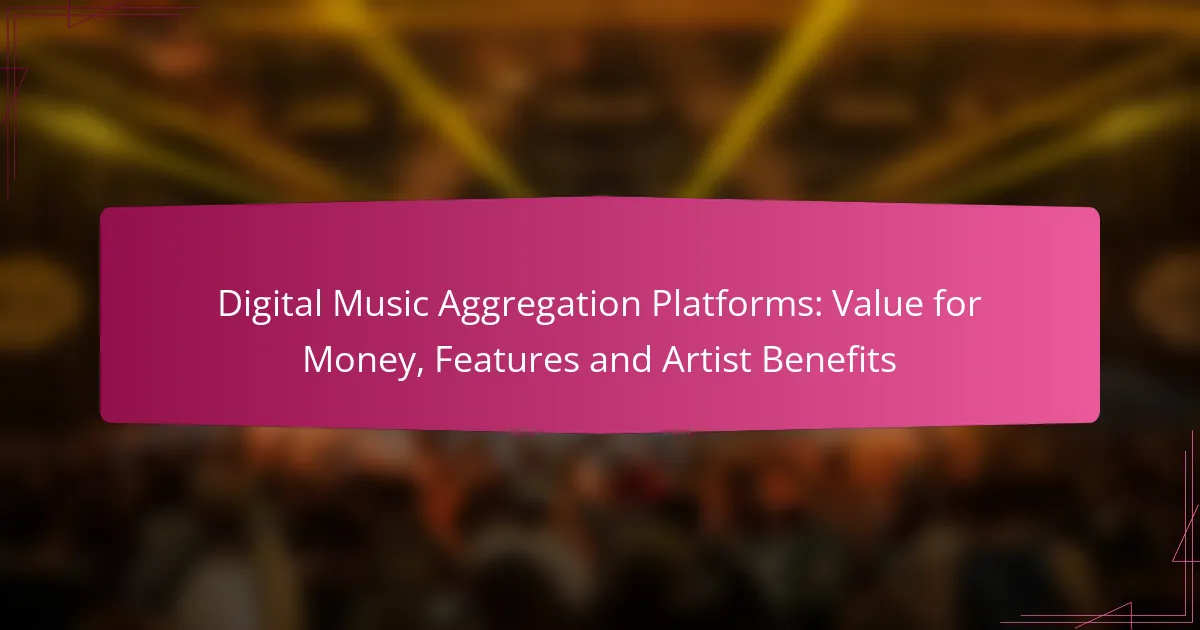Digital music aggregation platforms play a crucial role for artists by facilitating the distribution of their music across multiple streaming services while optimizing revenue potential. With options like DistroKid, CD Baby, and TuneCore, artists can choose platforms that best fit their needs, benefiting from low fees, flexible revenue models, and essential promotional tools to enhance their visibility in the competitive music landscape.

What are the best digital music aggregation platforms for artists?
The best digital music aggregation platforms for artists provide tools to distribute music across various streaming services while maximizing revenue and exposure. Key options include DistroKid, CD Baby, TuneCore, Amuse, and LANDR, each offering unique features and pricing structures to suit different needs.
DistroKid
DistroKid is known for its straightforward pricing model, allowing artists to upload unlimited tracks for a flat annual fee. This platform is ideal for musicians who release music frequently, as it does not take a percentage of sales, maximizing earnings.
One of DistroKid’s standout features is its fast distribution, often delivering music to platforms like Spotify and Apple Music within a few days. Additionally, it offers tools for managing royalties and promotional options, such as HyperFollow pages to help artists build their audience.
CD Baby
CD Baby operates on a pay-per-release model, charging a one-time fee for each album or single uploaded. This can be beneficial for artists who release music less frequently and prefer to avoid annual fees.
CD Baby also provides a range of services, including physical distribution, sync licensing opportunities, and comprehensive reporting on sales and streaming. Artists can choose between standard and pro services, with the latter offering additional benefits like publishing administration.
TuneCore
TuneCore charges artists an annual fee per release, which can add up if multiple albums or singles are released each year. However, it offers extensive distribution options and retains 100% of the royalties for artists.
Artists using TuneCore benefit from detailed sales reporting and the ability to distribute music to a wide array of platforms, including international stores. They also provide additional services such as music publishing and promotional tools to enhance visibility.
Amuse
Amuse offers a unique model by providing free music distribution with the option to upgrade for additional features. This makes it an attractive choice for emerging artists looking to enter the market without upfront costs.
In addition to free distribution, Amuse allows artists to keep 100% of their earnings. The platform also features a user-friendly app for managing releases and tracking performance, making it accessible for those new to digital music distribution.
LANDR
LANDR combines music distribution with mastering services, allowing artists to polish their tracks before release. This dual offering can save time and money for musicians who need both services.
With a subscription model, LANDR provides unlimited distribution and access to its mastering tools, making it suitable for artists who prioritize sound quality. They also offer promotional features to help artists reach wider audiences through various platforms.

How do digital music aggregation platforms provide value for money?
Digital music aggregation platforms offer value for money by enabling artists to distribute their music widely while minimizing costs. They typically charge low fees, provide flexible revenue sharing models, and include promotional tools that enhance visibility and sales.
Low distribution fees
Many digital music aggregation platforms charge minimal distribution fees, often ranging from a few dollars to around $50 annually. This is significantly lower than traditional record label costs, which can involve upfront investments and higher percentages taken from sales.
Artists should compare platforms to find the best deal, as some may offer free distribution for a limited number of tracks or specific promotional periods. Always check for any hidden fees, such as those for additional services or premium features.
Revenue sharing models
Revenue sharing models vary by platform, but most allow artists to retain a significant portion of their earnings, often between 70-90%. This is a stark contrast to traditional labels, which may take a much larger cut of the profits.
When selecting a platform, consider the percentage taken from streaming and download revenues. Some platforms offer tiered models where artists can earn more as their sales increase, providing an incentive for growth.
Additional promotional tools
Digital music aggregation platforms often include promotional tools that help artists reach wider audiences. These tools may consist of playlist placements, social media integrations, and marketing resources that enhance visibility.
Utilizing these promotional features can significantly boost an artist’s chances of success. Artists should actively engage with these tools and consider investing time in marketing strategies to maximize their reach and revenue potential.

What features should artists look for in a music aggregator?
Artists should prioritize features that enhance their distribution, provide valuable insights, and ensure reliable support. Key aspects include compatibility with various streaming platforms, robust analytics and reporting tools, and accessible customer support options.
Streaming platform compatibility
When selecting a music aggregator, ensure it supports a wide range of streaming platforms such as Spotify, Apple Music, and Amazon Music. The more platforms your music can reach, the greater your potential audience. Look for aggregators that provide distribution to both major and niche services to maximize exposure.
Additionally, check if the aggregator offers options for regional platforms, especially if you are targeting specific markets. For example, platforms like Deezer or Tidal may be more popular in certain countries, so having access to these can be beneficial.
Analytics and reporting tools
Effective analytics and reporting tools are essential for understanding your audience and tracking your music’s performance. Look for features that provide insights into streaming numbers, demographic data, and revenue breakdowns. These metrics can guide your marketing strategies and help you make informed decisions about future releases.
Some aggregators offer real-time data, while others may provide updates on a weekly or monthly basis. Choose one that aligns with your needs for timely insights, and consider those that allow you to track performance across multiple platforms in one dashboard.
Customer support options
Reliable customer support is crucial when issues arise with your music distribution. Look for aggregators that offer multiple support channels, such as email, live chat, or phone support. Quick response times can significantly reduce stress when dealing with distribution problems or payment inquiries.
Additionally, consider the availability of support resources like FAQs, tutorials, or community forums. These can provide valuable information and help you troubleshoot common issues without needing direct assistance.

What are the benefits of using a digital music aggregator for independent artists?
Digital music aggregators provide independent artists with essential tools to distribute their music widely, access royalties, and receive marketing support. By leveraging these platforms, artists can streamline their distribution process and maximize their revenue potential.
Wider distribution reach
Using a digital music aggregator allows independent artists to distribute their music across numerous streaming platforms and digital stores, such as Spotify, Apple Music, and Amazon Music. This broad reach increases the chances of gaining new listeners and expanding their fan base.
Aggregators typically have established relationships with these platforms, ensuring that music is delivered efficiently and in compliance with each service’s requirements. Artists should choose an aggregator that covers a wide range of platforms to maximize exposure.
Access to royalties
Digital music aggregators facilitate the collection of royalties from various streaming services and sales. Independent artists can earn money from streams, downloads, and even licensing opportunities, which are often challenging to manage without an aggregator.
Most aggregators provide transparent reporting on earnings, allowing artists to track their income over time. It’s crucial for artists to understand the fee structure of their chosen aggregator, as some may take a percentage of royalties or charge upfront fees.
Marketing support
Many digital music aggregators offer marketing tools and resources to help independent artists promote their music effectively. This can include playlist placements, social media promotion, and access to promotional tools that enhance visibility.
Artists should take advantage of these marketing features to create a cohesive promotional strategy. Engaging with fans through social media and utilizing the aggregator’s resources can significantly boost an artist’s presence in a competitive market.

How do music aggregators compare in pricing?
Music aggregators typically charge artists through various pricing models, including one-time fees, annual subscriptions, or percentage cuts from royalties. The choice of aggregator can significantly impact the overall costs and potential earnings for artists, so it’s essential to evaluate these factors carefully.
One-time fees
Some music aggregators offer a one-time fee structure, where artists pay a set amount to distribute their music. This model can be beneficial for those who prefer to avoid ongoing costs. Prices for one-time fees generally range from around $10 to $50 per release, depending on the platform and features included.
Annual subscriptions
Annual subscription models require artists to pay a yearly fee for ongoing distribution services. This can be a cost-effective option for artists releasing multiple tracks or albums throughout the year. Subscription fees typically vary from $20 to $200 annually, depending on the aggregator’s offerings and the level of service provided.
Percentage cuts from royalties
Many aggregators take a percentage of the royalties earned from streaming and sales, which can range from 10% to 30%. This model aligns the aggregator’s success with the artist’s earnings, but it can reduce the overall income for the artist. It’s crucial to read the fine print and understand how these cuts will affect your earnings over time.
